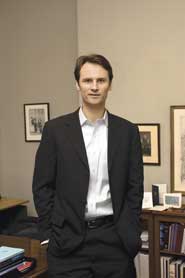Post Date: November 13, 2006
The following op-ed, What is technology’s role?, was written by Clinical Professor John Palfrey and published in The National Law Journal on November 8, 2006.
The first-year law school curriculum took shape more than 100 years ago. The basic curriculum hasn’t changed much over the course of the last century. Meanwhile, the practice of law has changed dramatically. One of those changes is the importance of information technologies in what young lawyers do as they enter the profession.
The Harvard Law School faculty recently voted in favor of substantial changes to our first-year curriculum. We aren’t the first law school to amend the first-year law school curriculum, but the changes are significant for at least two reasons. They passed unanimously, signaling a masterful job by the plan’s architects, Professor Martha Minow and Dean Elena Kagan. And the specific reforms, including introduction of a required course in international law, are well-conceived.
One question that remains unanswered is whether there’s a place for technology in the law school curriculum. Just as the profession has become global in scope-giving rise to new first-year courses in international and comparative law-the practice of law involves extensive use of information technologies. Young lawyers learn how to use technologies in practice on the job at law firms where training programs exist, and on their own if they’re in a smaller firm.
No one has figured out how to make academic computing fit in the law school curriculum. There are examples of extraordinary experiments-at New York Law School and Seton Hall University School of Law, to name a few-which merit evaluation.
Professor Charles Nesson, a pioneer in the use of technology in legal education and a founder of the Berkman Center for Internet & Society at Harvard Law School, is teaching an experimental class called “CyberOne: Law and the Court of Public Opinion.” He’s talking to students about how to make an argument not just to a judge, but to a global audience. As he puts it, CyberOne is “a course in persuasive, empathic argument in the Internet space.” Students are figuring out how to use blogs, podcasts, wikis, online video and virtual worlds to build their cases inside and outside of the courtroom. It’s out there-both figuratively and literally, as it’s also being taught in Second Life, a virtual world. Then again, Nesson is usually onto something when he’s out there.
These experiments may well lead to greater use of technology in law school classrooms. But the broader question lingers: Can technology play a transformative role in legal education at a systemic level? At the Berkman Center, in partnership with LexisNexis, we’ve begun a research project this fall to survey lawyers and law faculties about what they think on this front. By the end of the year, we expect to publish the results and highlight some of the most promising ways forward. We don’t yet know where this study will lead, but it’s pretty clear that the answer doesn’t lie in law schools starting to teach technology-specific courses. After all, a smart young lawyer can figure out how to use a new e-discovery software package in a few hours.
Practice-related courses
The hard problem is instead to figure out how to teach students to think about using technology in the context of the practice of law. One easy place to start: integrating technology into legal research and writing courses.
Another promising area is via clinical programs. Students benefit most from those clinical experiences that are authentic. Most practicing lawyers use case management software, e-discovery programs, research databases and time management tools on a regular basis. Costs aside, it’s hard to argue that clinical programs shouldn’t put these same tools in the hands of students. In areas where real cases are in short supply, technology might allow for effective simulation of legal practice. Professor Ethan Katsch of the University of Massachusetts Amherst has a promising set of experiments under way with simulation in dispute resolution and mediation.
The question of using technology in law schools raises the larger and tougher question of whether law schools are adequately connected to the practice of law and to members of the profession.
It’s less clear that there’s a role for technology in the doctrinal classes that constitute the backbone of legal education. For a first-year law student, the best way to learn might well be from an amazing contracts teacher who uses the Socratic method without a laptop or wifi access point in sight. On the other hand, real-time polling tools, wikis and Web logs-allowing students to build a collaborative online workspace on the proven model of the real-space study group-might make sense in an upper-level class on intellectual property.
Technology for technology’s sake, even if it’s cool, is not the point. Technology in law schools makes sense only in the service of pedagogy.
Law schools already turn out graduates who are excellent critical thinkers. Law schools that figure out how to work technology into the curriculum might be able to produce lawyers who are able to use technology to apply these critical thinking skills in a way that is transformative-for their practice, their clients and their societies at large.
